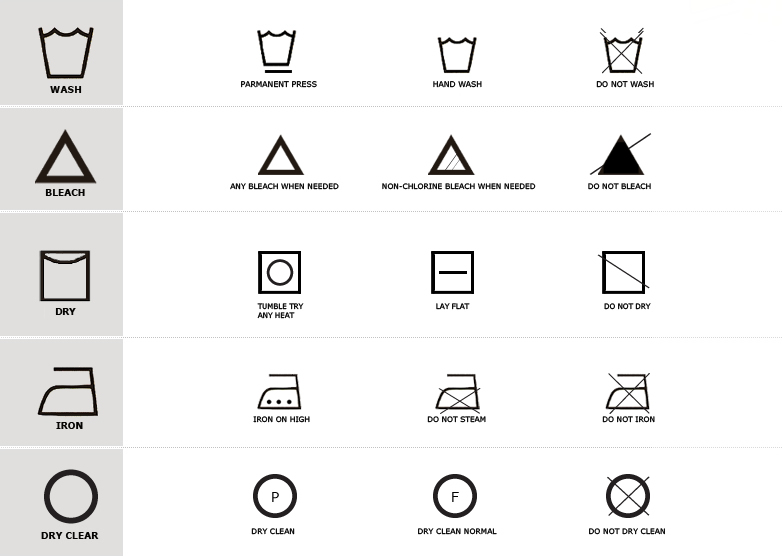Clothes are an integral part of who we are. Though you may only get a few uses out of the clothes you wear, taking care of it will allow us to wear the clothes more. Garment care is therefore an important aspect of taking care of ourselves.
SPECIAL CARE TECHNIQUES
Dry cleaning
Some fabrics must be dry cleaned, depending on the fibre content and construction. Always follow care instructions.
Drip-drying
Fabrics which are to be drip-dried should be hung to dry without squeezing or wringing. Garments handled in this manner will be less wrinkled and will retain their original shape better.
Care For Woollens and Knits
Woollens need careful handling. Wool fibres are covered with scales. If rubbed or soaked too long in hot water during laundering, the fibres swell and scales lock. This causes permanent shrinking and felting of fibres.
Handwashing a sweater:
-
Trace the outline of the sweater on paper.
-
Use warm soft water and mild soap flakes or a mild granulated detergent in water that feels lukewarm to touch.
-
Prepare suds, making sure flakes or granules are all dissolved. Too much soap will be difficult to remove from your sweater.
-
Squeeze suds through garment. Rubbing or wringing may stretch the garment out of shape.
-
Rinse several times in water the same temperature as the suds until the water is clear.
-
Roll in a towel and squeeze out the excess moisture. Do not wring.
-
To dry, lay flat on a dry towel, patting or pinning (using rust-proof pins) the wet garment into its original shape. Dry in a moderately warm place away from heat.
-
Mending Runs in Knits – Runs in knits should be mended as soon as possible to prevent further running. Run-stop fluid, nail polish or water will all stop runs temporarily.
-
Storage of Knits – Knits should be folded and never hung because the weight will tend to stretch the garment out of shape.
Storage of Woollens
-
Carefully wash or dry clean all garments before storing.
-
Spray thoroughly with a moth repellent or sprinkle generously with moth balls or crystals.
-
Seal the clothing in a paper garment bag or package. Make sure the container is air-tight.
-
Silks
Follow fabric care instructions. Are usually cleaned by dry cleaning or washed by hand. Washable silks can be machine washed. If you plan to wash a silk garment, test a fabric sample to determine colourfastness. Hand wash pure silk in warm water and a mild detergent, rinse in cool water, towel dry and press fabric while slightly damp.
Leather and Suede
Must be dry cleaned. Wipe leathers clean with a damp cloth; suedes can be cleaned by brushing with a bristle brush. Leather creams can be used to restore leather’s natural oils and special leather protector sprays and creams are available to help maintain and protect leather. Shiny spots on suede may be brushed up using a fine emery board.
Sheers and Laces
Clean fabrics according to label instructions. Press carefully – synthetic sheers and laces pucker when pressed with steam. Cushion seams with brown paper strips to prevent press marks on the outside of the garment.
Synthetic Suedes
Most synthetic suedes can be machine washed and dried – check the label. Press at a lower temperature to prevent melting and use lots of steam. Be careful not to flatten the nap. A thick press cloth or several press cloths will prevent your iron from leaving imprints on the fabric’s surface. The nap can be restored by steaming and brushing the fabric with a soft bristled toothbrush.
Fake Furs
Fake furs may be washable or dry cleanable depending on the fibre content. When pressing, use plenty of steam and if possible, steam lightly without touching the fabric so as not to flatten the nap. You may also wish to use a needle board.
Pile Fabrics
Fibre content will determine washability. Because of their nap, pile fabrics should be lightly steam-pressed using a needleboard.
“Outdoor” Wear
-
The fibre content of the fabrics used in the outdoor item will determine the method of cleaning. Insulated garments require a little extra attention.
-
Down-filled items can be dry cleaned, washed by hand, or by machine on the gentle or delicate cycle. When washing, use mild soap or detergent. Down garments can be machine dried at a low heat. Add several bath towels and a pair of clean running shoes. The towels help absorb the moisture and the shoes beat and separate the down clumps. Be sure the down is completely dry because it will mildew if left damp. Down can also be dry cleaned.
-
Clean items insulated with polyester batting by machine washing on a gentle cycle and drying at a low heat.
For off-season storage, store insulated items loosely folded or hang over a hanger in a clean, dry place. Don’t compress tightly. Don’t use plastic bags because they prevent the item from breathing and allow moisture to build up and cause mildew. -
Down items can be fluffed up in a warm dryer to restore the down to its maximum loft after storage.
-
Special adhesive mending tape is available for use on insulated item tears. Repair all tears immediately to keep the insulation from coming out.





